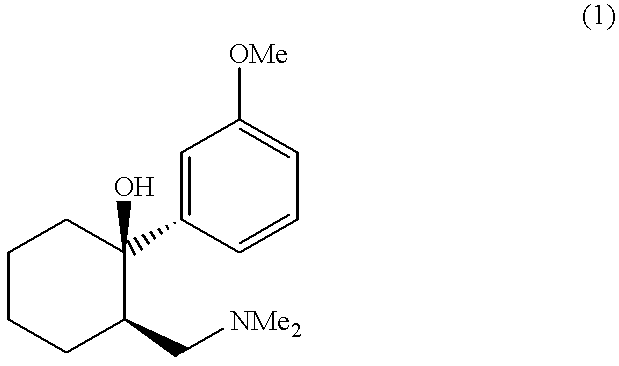Process
a technology of process and process, applied in the field of process, can solve the problems of unsuitable and economic operation on a larger scale, inability to reproduce, and inability to meet the requirements of large-scale operation
- Summary
- Abstract
- Description
- Claims
- Application Information
AI Technical Summary
Problems solved by technology
Method used
Image
Examples
example 1
Resolution of (+ / -)-Tramadol with Di-p-toluoyl-L-tartaric Acid in Ethanol
57 g of racemic Tramadol hydrochloride (0.190 mol) was taken up in 110 mls of distilled water. To this yellow coloured solution is added 120 ml of dichloromethane, and the reaction mixture stirred at 10.degree. C. in a jacketed vessel. A solution of 36% sodium hydroxide 22 ml is added dropwise to the tramadol hydrochloride. After 10 minutes stirring the layers are allowed to separate, and the bottom organic layer removed. The basic aqueous layer is re-extracted with 35 ml of dichloromethane and combined with the first organic layer. These are then washed with water 100 ml. Concentration of the organic layers under vacuum gives the racemic tramadol free base in quantitative yield (50 g) as a yellow oil. The free base is taken up in 200 ml of ethanol and this solution is added to the Di-p-toluoyl-L-tartaric acid ((L)-(-)-DTTA) 73.4 g (0.190 mol) in 700 ml of ethanol at 70.degree. C. On cooling to 65.degree. C. a ...
example 2
Resolution of (+)-enantiomer-enriched Tramadol with Di-p-toluyl-D-tartaric Acid in Ethanol
The (+)-Tramadol-containing salt from Example 1 was cracked using 2.1 equivalents of sodium hydroxide as follows. The (+)-Tramadol. (L)-(-)-DTTA salt 131 g (0.202 mol) in 1 volume of ethanol was taken up in 150 ml of dichloromethane and placed in a jacketed vessel at 10.degree. C. To this yellow coloured solution was added water 300 ml and the mixture stirred. To this mixture was added a solution of 16.8 g sodium hydroxide (0.423 mol) in 200 ml of distilled water dropwise with stirring. The layers were then separated, the bottom organic layer collected. The basic aqueous layer was re-extracted with 150 ml of dichloromethane. The organic layers were combined and washed with water 200 ml before concentrated to dryness. This gave approximately 53 g of Tramadol free base enriched in the (+)-enantiomer as a slightly coloured oil. The basic aqueous layer was acidified with hydrochloric acid to pH=2.0...
example 3
Resolution of (+ / -)-Tramadol with Recovered Di-p-toluoyl-L-tartaric Acid in Ethanol
11.4 g of racemic Tramadol hydrochloride was converted to the racemic tramadol free base in quantitative yield (10 g) as a yellow oil using the same procedure outlined in Example 1. The free base is taken up in 20 ml of ethanol and this solution is added to the Di-p-toluoyl-L-tartaric acid ((L)-(-)-DTTA) (which was recovered from a previous resolution) 14.7 g (0. 038mol) in 120 ml of ethanol at 70.degree. C. On cooling to 65.degree. C. a precipitate forms. The resolution is gradually cooled to 25.degree. C. and left to age over a period of approximately fifteen hours.
The copious white precipitate that formed was collected by filtration, washing with 60 ml of ethanol. This gave after drying 11.40 g (46.2%) of (-)-Tramadol. Di-p-toluoyl-L-tartaric acid salt with a de of 96.2% (chiral HPLC). Evaporation of the mother liquors gave a slightly coloured oil 13.50 g (>55%), of (+)-Tramadol. Di-p-toluoyl-L-tar...
PUM
| Property | Measurement | Unit |
|---|---|---|
| volume | aaaaa | aaaaa |
| volume | aaaaa | aaaaa |
| optical purity | aaaaa | aaaaa |
Abstract
Description
Claims
Application Information
 Login to View More
Login to View More - R&D
- Intellectual Property
- Life Sciences
- Materials
- Tech Scout
- Unparalleled Data Quality
- Higher Quality Content
- 60% Fewer Hallucinations
Browse by: Latest US Patents, China's latest patents, Technical Efficacy Thesaurus, Application Domain, Technology Topic, Popular Technical Reports.
© 2025 PatSnap. All rights reserved.Legal|Privacy policy|Modern Slavery Act Transparency Statement|Sitemap|About US| Contact US: help@patsnap.com

